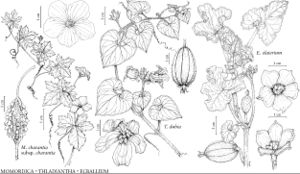Ecballium
in J. B. Bory de Saint-Vincent et al., Dict. Class. Hist. Nat. 6: 19. 1824.
| Taxon | Illustrator ⠉ | |
|---|---|---|
 | Momordica charantia subsp. charantia Thladiantha dubia Ecballium elaterium | Yevonn Wilson-Ramsey Yevonn Wilson-Ramsey Yevonn Wilson-Ramsey |
Plants perennial, monoecious, prostrate, trailing; stems annual, villous-hirsute; roots tuberous; tendrils absent. Leaves: blade triangular to hastate or ovate-triangular, unlobed, base cordate, margins crenate to crenate-dentate, usually prominently sinuate-undulate or sinuate-crisped, appearing whitish because of light-colored abaxial surfaces, surfaces eglandular. Inflorescences: staminate flowers 1 or 2–8 in axillary racemes; pistillate flowers solitary, from same or different axils as staminate, peduncles recurved-nodding in fruit; bracts absent. Flowers: hypanthium broadly campanulate; sepals 5, lanceolate; petals 5, distinct nearly to base, [cream] pale-yellow or white with [darker and brighter] yellow [greenish] center, oblong-ovate, abruptly acuminate apically, 6–16 mm, puberulent, corolla campanulate to rotate-campanulate. Staminate flowers: stamens 5, 2 connate in pairs, 1 distinct, appearing as 3 stamens; filaments inserted near hypanthium rim, distinct; thecae distinct, sigmoid, connective broadened; pistillodes absent. Pistillate flowers: ovary 3-locular, muricate-hispid to muricate-hispid-hirsute, dehiscing explosively, expelling seeds through ruptured pedicel attachment. Seeds 40–100, ovoid, compressed, not arillate, obscurely margined, surface smooth. x = 9.
Distribution
Introduced; e, se, sw Europe, w Asia, n Africa, also in w Europe, Australia
Discussion
Species 1.
Ecballium plants are prostrate and without tendrils, and the hastiform leaves have crisped-undulate margins that appear whitish because of the light-colored abaxial surfaces. The erect peduncles are sharply nodding near the base of the fruit such that the mature fruit is pendent.
The explosive dehiscence is stimulated by touching the peduncle near the fruit. The ripening fruit becomes turgid with mucilaginous fluid. Increasing pressure from the maturing and enlarging seeds forces the fruit to break away explosively from the plant and the seeds are ejected in a mucilaginous stream to several meters. The epithet (Greek, elaterios, driving) either reinforces the generic name or alludes to the violently purgative properties of the plant.
Selected References
None.